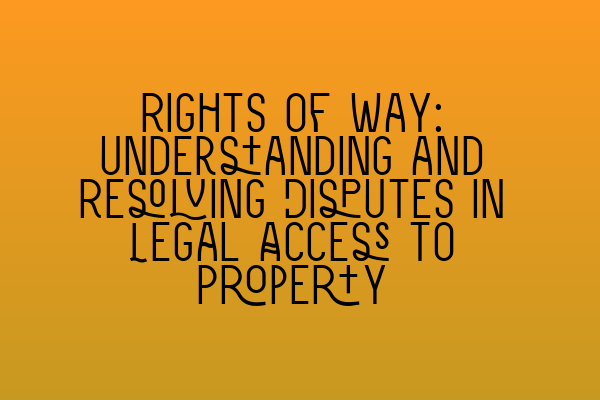Rights of Way: Understanding and Resolving Disputes in Legal Access to Property
Introduction
Rights of way are an essential aspect of property law that governs the legal access to a property. Understanding the rights and resolving any disputes related to them can be complex and challenging. This blog post aims to provide a comprehensive guide to rights of way, empowering property owners with the knowledge they need to navigate these issues successfully.
What are Rights of Way?
A right of way is a legal right that grants someone the entitlement to pass over or use another person’s property, usually in a specific manner. It can be granted explicitly through a legal agreement, such as an easement, or implied through continuous use over time. These rights are crucial for ensuring proper access to a property, particularly when there is no public road leading to it.
Types of Rights of Way
There are several types of rights of way, each with its own unique characteristics and legal implications. Some common types include:
1. Private Rights of Way: These rights are granted to specific individuals or properties, allowing them exclusive access over a defined area. Private rights of way are often created through legal agreements or historical usage.
2. Public Rights of Way: These rights are open to the general public and are typically established through historical usage, common law, or official dedication by a public authority. Public rights of way can include footpaths, bridleways, and byways.
3. Prescriptive Rights of Way: Also known as easements by prescription, these rights are acquired through continuous use of another person’s land for a specific period, usually 20 years or more, without interruption. Prescriptive rights of way can be claimed even if no formal agreement exists.
Common Causes of Rights of Way Disputes
Disputes regarding rights of way can arise due to various reasons, including:
1. Unclear or Ambiguous Agreements: Poorly drafted legal agreements or unclear documentation can lead to disputes regarding the scope and extent of a right of way.
2. Unauthorized Use: When someone uses another person’s property without legal entitlement or exceeds the permitted rights, conflicts can arise.
3. Blocked Access: If access to a property is obstructed for any reason, such as fences, gates, or other barriers, it can trigger disputes regarding the right of way.
Resolving Rights of Way Disputes
Navigating rights of way disputes can be time-consuming and complex, requiring legal expertise. Here are some steps to consider when facing such conflicts:
1. Review Legal Documentation: Carefully examine any legal agreements, deeds, or documents related to the right of way. Seek professional advice to interpret them accurately.
2. Mediation or Negotiation: Attempt to engage in dialogue with the other party involved to find a mutually agreeable solution. Mediation or negotiation can often help resolve disputes without resorting to litigation.
3. Seeking Legal Assistance: If informal resolution methods fail, it may be necessary to seek legal assistance from a solicitor specializing in property law. They can guide you through the process, represent your interests, and help reach a fair resolution.
Conclusion
Rights of way play a vital role in ensuring proper access to a property. However, disputes related to these rights can be complex and require professional assistance to resolve effectively. By understanding the different types of rights of way, common causes of disputes, and the steps involved in resolving them, property owners can navigate these issues with confidence. Remember, seeking legal advice is crucial to protect your rights and interests in rights of way disputes.
Related Articles:
– SQE 1 Practice Exam Questions
– SQE 1 Practice Mocks FLK1 FLK2
– SQE 2 Preparation Courses
– SQE 1 Preparation Courses
– SRA SQE Exam Dates
